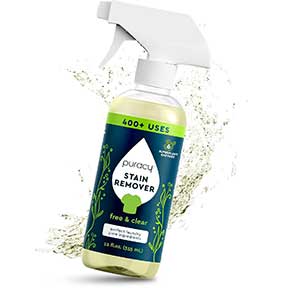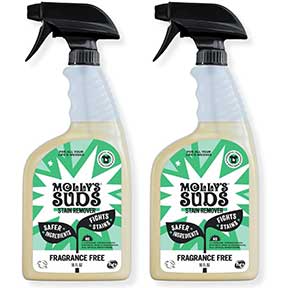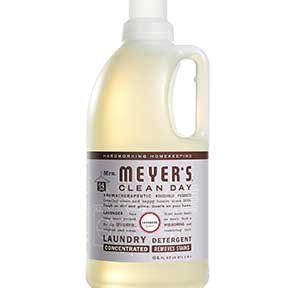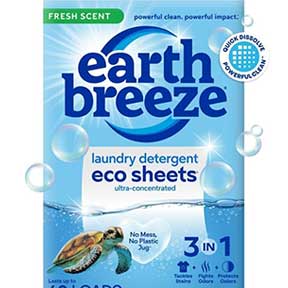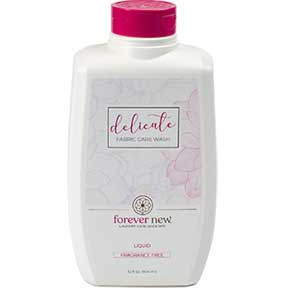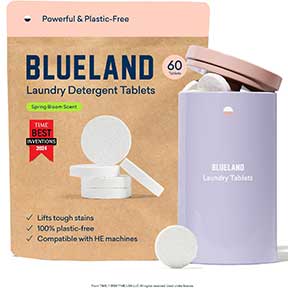Laundry 101: Part 2 – Removing Stains

What Mom Didn’t Tell You about Removing Stains
After many years of cleaning, we’ve learned some important things about the cleaners we use, and this impacts how we clean laundry and remove stains.
There’s nothing really complex or earth-shattering about it. But why on earth should getting laundry clean and removing stains be hard? In fact, I’ve got it all simplified and laid it out in easy steps. It should have never been so complicated to start with.
In Laundry 101 Part 1, we talked about stains, the different stain types and some stain removal methods. But that was just a part of it and here we continue on with stains and the variety of products you can use to remove them.
Buy and Use the Basic Cleaners
I don’t buy dishwashing detergent that contains bleach or laundry detergent that contains oxygen bleach. Adding extra chemicals without having the need to use them is not beneficial and can also be damaging in the long run. It also complicates things in the event you want to use a cleaner for something else. As an example: dishwashing detergent does not need bleach to start with. It’s excessive and one more chemical in your environment that’s going down the drain.
Use Your Cleaners with a Purpose in Mind
The flip side of my point above is to use the products specific to your need. When you need brightening and lightening, pull out the cleaners you need and use them. It’s less wasteful, less toxic to you and less damaging to your clothing. Bleach for example, degrades plastic gaskets, fades clothing, and is destructive to fabric.
Use as Little Cleaning Solution as Possible to Get the Job Done
Don’t throw a bunch of cleaners at a problem without knowing what you are doing. More is not always better and it’s certainly not the case when cleaning your clothes or removing stains.
Use the Gentlest Method to Remove a Stain as Possible
You don’t need to use a bulldozer when a shovel will do, and that goes for all stains.
Do Not Underestimate the Power of Simple and Natural Methods
I don’t have all of the non-toxic cleaners listed, but many of the simple and natural methods to clean, such as vinegar, baking soda, borax, lemon juice, and even sunlight and fresh air might be truly the best and most effective way to get something clean. It’s easy to be brain washed into thinking we need to buy some expensive specialty cleaning solution if we don’t have the experience to know what else works.
And last but not least…
Read the Manual, Label or Product Instructions. No Exceptions.
I’ve missed out on some valuable information that would have saved me a lot of trouble if I only read a label. I’ve learned the hard way, but I did learn.
Stain Sticks and Sprays
I have to admit I don’t typically buy specialty stain removers and our clothes are not stained. I get great results using the basic cleaning products I already have at home. It’s not only cheaper, but it’s more efficient as well.
Having a stain stick or spray in case of emergencies might be a good idea in your home, but you don’t have to use all those stain sticks, sprays and magic elixirs, despite what the advertisements say. Everything you need to remove stains is probably listed right here.
There are a variety of commercial spot removers on the market, usually in the form of a spray or sticks. You apply the stain remover to the stain, wait for the time directed, and then wash.
If you go this route there’s not a lot more that needs to be said, other than to check the product instructions to see if the stain remover was meant to remove the type of stain you are working on.
Different Stains, Different Cleaning Solutions
Grease, coffee, blood, rust, grass or inks all need different cleaning solutions. A lot of frustration can be avoided if you make sure that the stain stick you’re using is meant to remove the stain you’re working on. Removing stains is not a “one size fits all” type of problem.
Making Your Own Stain Stick
If you’re the crafty type, you can make your own stain stick, laundry detergent and even bar soap. The website Frugally Sustainable published a detailed recipe with some easy instructions on how to make your own stain stick. I really like the idea because you control the ingredients, chemicals and scent, if you even choose to use any scent at all. Adding essential oils, like lavender or rosemary makes it really appealing to me, I love essential oils.
The ingredients are very basic. And don’t be afraid of the lye and lard in the recipe. Soap has been made this way for centuries. It’s an age-old recipe.
Homemade Laundry Stain Stick
- 2 pounds lard
- 4.39 ounces lye
- 10 ounces water
- 1 ounce eucalyptus essential oils, optional
- 1/2 ounce lemon essential oils, optional
If you are interested in making your own stain stick or laundry soap, the frugally sustainable web site has the complete instructions for making homemade soap.
But my point is that a stain stick is really just concentrated laundry detergent, but in a different form. Save your money. Your laundry detergent, dish soap or shampoo is a concentrate that can work just as well as a stain stick. Hydrogen peroxide, oxygen bleach, or enzyme products can be used as needed depending on the specific stain you are working on. That’s just about all you need.
Using Laundry Detergent or Dish Soap to Remove Stains
Laundry detergent and dish soap are what I reach for to remove grease, oil, and many food stains.
They are the best pre-treatment items for grease and oil. After all, soap and detergent are made to cut grease, remove oil, dirt and grime from your laundry and dishes. It makes perfect sense that they’re wonderful stain removers too, doesn’t it?
Avoid using detergents that have chlorine or oxygen bleach in them to pre-treat a stain. Chlorine bleach may discolor your clothing, and though oxygen bleach is color safe, if the rest of the garment is somewhat dingy, there’s a possibility the oxygen bleach may lighten the appearance slightly and that would be a problem too. I don’t know of any laundry detergents that have chlorine bleach in them, but some have oxygen bleach. I’ve seen some dish soaps that contain chlorine bleach, so just be careful and double check before using them.
Treating a Stain with Detergent and or Dish Soap
- Rinse the stain in lukewarm/warm water to remove any solids
- Do not use hot water as you want to avoid spreading the stain further
- Pour a little of the concentrated laundry/dish soap right on the stain
- Rub in gently with your fingers
- Let it sit for about 30 minutes
- Repeat as necessary
- Launder according to the fabric and detergent instructions
- Any remaining stain might require a different cleaning solution
Using straight laundry detergent to remove stains has saved me a ton of money.
If you’ve caught it quickly enough, and the grimy dirt is removed there’s a good chance the stain will be removed too.
Using Hydrogen Peroxide/Oxygen Bleach to Remove Stains
I love using hydrogen peroxide to remove stains. It’s the cleaning solution I use to remove coffee stains without damaging fabric. Hydrogen peroxide has all the benefits of using chlorine bleach without the risks.
Hydrogen peroxide is very similar to water- it’s just missing an atom or so. But because it’s an oxidizer, it lightens, brightens and removes stains. The bleaching action is called “redox” which is short for reduction-oxidization. That’s the same way chlorine bleach works to remove stains.
Hydrogen peroxide converts to water when exposed to sunlight, which is nice because it means it leaves no residue, but that also means it won’t work if you are trying to remove a stain and it’s being exposed to sunlight at the time you are working on it. (This is why hydrogen peroxide comes in a dark brown bottle.) You can cover it with a towel, dishcloth, etc if needed.
If you haven’t used hydrogen peroxide and are worried about color-fastness, test in an inconspicuous place first.
Hydrogen peroxide helps to remove these kinds of stains:
- Blood stains
- Coffee stains
- Rust stains
- Iron stains
- Red wine stains
- Fruit Juice stains
- Berry stains
Removing Stains with Hydrogen Peroxide
- Pour regular 3 percent hydrogen peroxide on the stain
- Check in 1 hour
- Apply more hydrogen peroxide if needed
- Let it sit for 30 minutes
- Let air dry completely
- Repeat if necessary
If you need to remove a stain that’s in direct sunlight (like on the carpet or similar):
- Follow the cleaning steps (above)
- After you have applied the hydrogen peroxide
- Cover the stain with a sheet of plastic wrap
- Put a towel on top to shield the stain from the sun
- Check in 1 hour
- Apply more hydrogen peroxide if needed
- Cover the stain with the plastic and towel again
- Check after 30 minutes
- Let air dry completely
- Repeat if necessary
The plastic wrap will stop the towel from soaking up the hydrogen peroxide, and the hydrogen peroxide will happily continue to work on the stain in the dark!
I don’t have to worry about direct sun exposure, so I usually lay the stained item flat on my washing machine, and pour the hydrogen peroxide right on the top of the stain. It’s easy to keep track of the progress, and when the stain is gone, I just toss my garment in the washing machine.
Using Oxygen Bleach to Remove Stains
Oxygen bleach (like oxyclean) is NOT hydrogen peroxide, but the effects are the same. Hydrogen peroxide is a liquid, and oxygen bleach is sodium percarbonate or sodium perborate. These chemicals are oxidizers that are stable in a powder form.
When sodium percarbonate or sodium perborate is combined with water, oxygen is released. This chemical reaction removes the stain, breaks up grime and brightens the fabric.
The cleaning and bleaching reaction occurs at the time the powder is mixed with water, so you can’t mix the solution ahead of time and put it in a spray bottle to use later (just in case you were thinking of doing that).
Because there are mineral solids in oxygen bleach, there will be a residue from the powder. That powder will need to be completely rinsed and removed after using it.
Using Rubbing Alcohol (Isopropyl Alcohol) to Remove Stains
Rubbing alcohol (Isopropyl alcohol) or methylated spirits (Denatured alcohol) are great all-purpose spot removers.
Isopropyl alcohol evaporates quickly and is fairly non-toxic. Rubbing alcohol is a solvent and a cleaning fluid. Alcohol helps to dissolve (make soluble) many different types of stains, including oil, and then you can wash or rinse it away.
Rubbing alcohol is a solvent and works to remove:
- Ground in grass stains
- Water based ink stains
- Permanent marker ink stains
- Ballpoint pen ink stains
- Chewing gum
- Pencil lead
- Mustard stains
- Shoe polish stains
- Paint stains
- Varnish stains
- Hair dye stains
- Black heel marks
- Red wine stains
- Residual glue from some sticky labels
Removing Stains with Rubbing Alcohol
- Place a clean dry cloth under the stained fabric
- Dab rubbing alcohol onto the stain
- Blot with a clean dry cloth
- Dab, blot, dab, blot, dab, blot until no stain remains
- Add a little laundry detergent on top of the stain
- Let sit for 15 minutes
- Wash in the hottest water that is safe for the fabric
- Check the stain before you put it in the dryer
- If any stain remains, repeat step 1
Ammonia and Stain Removal
Ammonia smells to high heaven, but it works and has been used for centuries as a cleaner but don’t worry; the smell should be gone when your wash load is complete.
Ammonia works by saponification to remove greasy oil stains- That is: it chemically converts the stain to soap, and then the stain will be washed away. Other types of stains are dissolved due to the high alkalinity of the cleaning solution.
CAUTION: Never mix ammonia with bleach or with products that contain chlorine bleach.
Ammonia and bleach combined together will produce a hazardous gas. Chlorine gas and chloramines are formed, and those most certainly are not a joke. Chlorine gas can cause severe lung damage and can be life threatening.
Personally, I might think twice about letting bleach and ammonia sit next to each other on the shelf. Am I over reacting? Possibly but it’s better to be safe than sorry. It may also be a good idea to wear a mask and gloves when using ammonia and use in well ventilated area.
In all honesty I’ve been unfortunate enough to breathe chlorine gas. It took my breath away. Call me paranoid, but I most definitely do not want to repeat that experience ever again.
Ammonia helps to remove these stains:
- Perspiration stains
- Set in blood stains
- Urine stains (CLOTHING STAINS ONLY-Don’t use it on carpet)
- Pencil marks
- Paint stains
- Grease stains
Removing stains with ammonia:
- Saturate the stain with a 50/50 solution of ammonia and water
- Massage in gently
- Let sit for 30 minutes
- Launder as usual
Removing heavy duty stains with Ammonia
Make a cleaning solution consisting of:
- 1 cup of warm water
- 1/2 cup of ammonia
- 1/2 cup laundry detergent
Spray the solution on the stain and let it sit for 30 minutes. Then rinse and wash as usual.
IMPORTANT: NEVER MIX AMMONIA WITH CHLORINE BLEACH. A TOXIC GAS WILL RESULT DUE TO A CHEMICAL REACTION. I think it’s worth saying this again, just in case if you didn’t pay attention to my first warning!
Using Club Soda as a Stain Remover
Club soda is a fun and effective stain remover (I know, I’m a little weird). The effervescent bubbles help to bring the stain to the surface of the fabric where it can be simply blotted and washed away. Club soda is an excellent stain remover for red wine stains. The trick is to get to it fast.
If red or white wine have stained your clothing:
- Pour 1/4 cup of club soda on the spilled wine
- Blot, blot, blot to remove the residue.
- Pour 1/4 more cup of club soda on the spilled wine
- Blot, blot, blot to remove the rest of residue
- Launder the garment as usual
Denture Cleaning Tablets Can Help Remove Stains
Denture cleaning tablets are acidic, and the acid helps to remove stains from many things. Coffee stains, tomato sauce, or any other acid based stain can be removed using denture cleaners. It’s also great for removing stains from cotton whites and linens.
Denture cleaning tablets help to remove these stains:
- Coffee stains
- Tea stains
- Food dye stains
- Perspiration Stains
- Mustard stains
- Tomato based stains
Removing stains with denture cleaning tablets:
- Put the denture cleaner tablets in a glass
- Add water and let the tablets dissolve completely
- Pour on the stain and massage in gently
- Let sit for 30 minutes
- Launder as usual
- If the stain remains after washing, go back to step 1 and repeat.
- Do not dry your stained item in the dryer until the stain is completely gone.
Using Glycerin for Stain Removal
Glycerin is a byproduct of soap making (saponification) and is a combination of fat and oils.
Glycerin is an excellent solvent and is useful in softening old or set stains. Because it is a byproduct of soap, it’s an excellent cleaner and degreaser. It helps to loosen makeup, lipstick, ink and shoe polish stains.
Glycerin helps to remove these stains:
- Juice stains
- Ketchup
- Mustard
- BBQ sauces
- Coffee
- Self-tanning lotion
- Lipstick
- Ink
- Marker
Recipe for glycerin stain remover:
To make an excellent glycerin stain remover, mix 1 part glycerin to 2 parts water and add some mild detergent for extra cleaning and degreasing power:
- 2 tablespoons liquid dish detergent (like Dawn)
- 1 cup glycerin
- 2 cups water
Removing Stains with Glycerin
- Spray or pour a small amount of the glycerin cleaning solution right on the stain
- Massage it in gently
- Let sit for 30-60 minutes
- Launder as usual
Shaving Cream Can Help in the Stain Removal Process
Shaving cream is not just for removing hair! Made from soap, oil, surfactant, water and alcohol, shaving cream is both easy to use and very effective for removing many greasy, oily clothing stains.
Removing fabric stains with shaving cream:
- Work a squirt of shaving cream with your fingertips into dampened fabric
- Let it sit about 30 minutes
- Wash as usual
Shaving cream is also a good stain remover for carpet stains:
- Squirt the shaving cream on the stain
- Work it gently into the carpet
- Let it sit undisturbed for 30 minutes
- Use a clean rag dampened with plain water and dab, dab, dab the stain away
Protein Enzymes and Meat Tenderizer are Effective Stain Removers
Meat tenderizers are enzymes that tenderize meat by breaking down and dissolving tough fibers. Enzymes are effective stain removers for protein based stains:
- Milk
- Chocolate milk
- Ice cream
- Blood
- Baby food
- Gravy
- Eggs
- Meat
- Urine
Luckily for us, the natural enzymes we buy for meat tenderizer are easy, safe, plant based and do a great job removing stains. To use a meat tenderizer as a protein stain remover, find one that does not contain additional seasonings like garlic and salt. Just straight meat tenderizer.
Look for either active ingredient, both of these will work:
- Bromelain: a protease enzyme that comes from the stems of pineapple plants and is the active ingredient in Mccormick’s Unseasoned Meat Tenderizer.
- Papain: a protease enzyme that comes from papayas and is the active ingredient in Adolph’s Meat Tenderizer.
Now let’s take a look at Laundry 101 Part 3 – Brightening Whites
Clothing and Laundry
